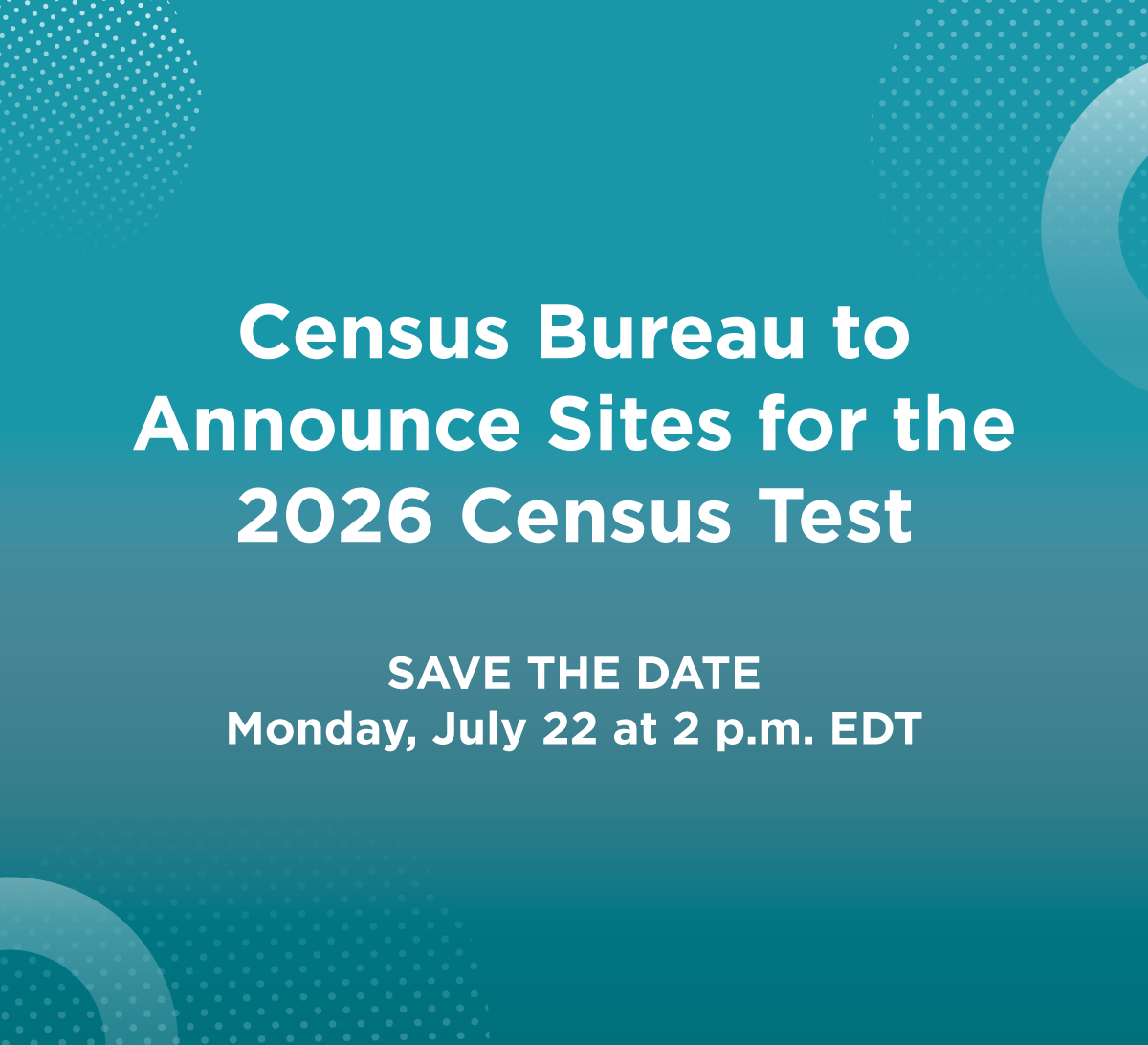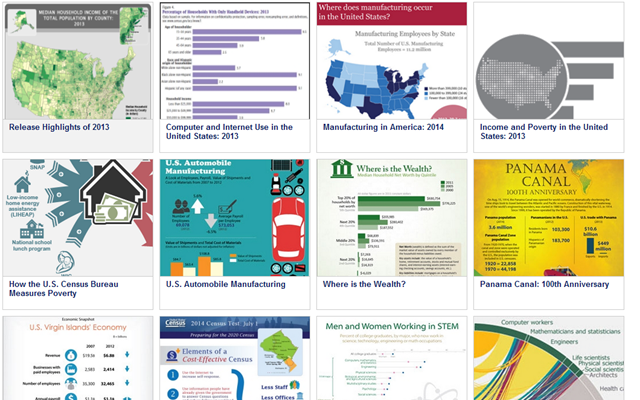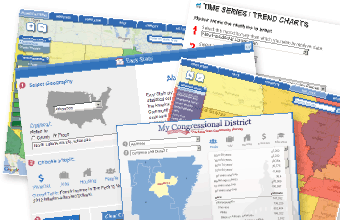Tip Sheet Number 3 — February 9, 2024
Upcoming
2024 Product Calendar
The U.S. Census Bureau has posted anticipated release dates for each regular and recurring statistical product scheduled for release in 2024. These products are listed in the Census Bureau’s online product calendar, which is updated as needed throughout the year.
2030 Preparation
Initial Strategies for 2030 Census Preparations
The Census Bureau plans to release five strategy documents outlining how it plans to carry out the next decennial census. The strategies cover the Census Bureau’s approach for conducting a complete count, designing operations, developing the IT solution, sourcing contracts and engaging with stakeholders for the 2030 Census. (Tentatively scheduled for release in February.)
2020 Census
2020 Island Areas Censuses Detailed Cross-Tabulations Data
The Census Bureau will release detailed cross-tabulation data for the U.S. Island Areas: American Samoa, the Commonwealth of the Northern Mariana Islands, Guam and the U.S. Virgin Islands. The release includes 95 demographic, social, economic and housing characteristics tables. These characteristics are cross tabulated by race, age, sex, place of birth, educational attainment, labor force status, occupation, industry, and income and earnings. Housing characteristics are cross tabulated by age of householder, household income in 2019, household size, tenure, units in structure and year built. This final release of 2020 Island Areas Censuses data includes the Island Area and county levels of geography. More information is available on the 2020 Island Areas Censuses Data Products webpage. (Scheduled for release February 15.)
American Community Survey
New Brief on the Commuting Patterns in the United States and Puerto Rico
The U.S. Census Bureau will release a brief highlighting the newest available statistics on commuting behavior from the American Community Survey (ACS). Commuting in the United States: 2022 will explore recent commuting trends in the United States and Puerto Rico using estimates from the 2022 ACS 1-year dataset, with comparisons to ACS data from 2019 and 2021. The brief highlights changes in the way people travel to work since the onset of the COVID-19 pandemic, variation in commute time by year and across different types of community, and shifts in the distribution of workers leaving for work at different times of day between 2019 and 2022. (Tentatively scheduled for release February 20.)
New Report on the Nation’s Foreign-Born Population
The U.S. Census Bureau will release new data products highlighting select demographic and socioeconomic characteristics of the nation’s foreign-born population. The Foreign-Born Population 2022 report compares 2010 and 2022 American Community Survey (ACS) 1-year estimates to provide insight into the changing composition of the foreign-born population in the United States. The Highlights of the Foreign-Born Population data visualization displays 2018-2022 ACS 5-year estimates about the foreign-born population at various levels of geography, including national, state and county. (Tentatively scheduled for release February 21.)
Demographic
Census Bureau Releases 2022 Community Resilience Estimates Equity Supplement
The U.S. Census Bureau will release the 2022 Community Resilience Estimates Equity Supplement, an update to the CRE for Equity Interactive Tool, for U.S. areas most socially vulnerable to disasters. The Community Resilience Estimates Equity Supplement shows a connection between income inequality and higher social vulnerability to the impact of disasters and includes new 2022 equity estimates with race-iterated variables that allow users to examine select topics related to social vulnerability by specific racial and Hispanic origin groups. (Scheduled for release February 20.)
Household Pulse Survey
The experimental Household Pulse Survey (HPS) is an effort by the Census Bureau and other federal statistical agencies to measure how emergent issues are impacting U.S. households from a social and economic perspective. Phase 4 topics include employment status, spending, food security, housing, health, mental health, natural disasters, inflation and spending, vaccine receipt, COVID-19 diagnosis and treatment, shortage of critical products, disability, income, social connection and child care arrangements. Data collection for phase 4.0 began January 9, with data dissemination, including detailed data tables and public-use files on a monthly basis. (Scheduled for release February 22, March 21, and April 18.)
Economic
Transitioning Multiple Annual Economic Surveys to the new Annual Integrated Economic Survey
The U.S. Census Bureau will announce the launch of the Annual Integrated Economic Survey (AIES) beginning in March. This new program replaces seven annual economic surveys, streamlining reporting by consolidating all necessary questions into one convenient survey. The AIES will replace the Annual Capital Expenditures Survey (ACES), Annual Retail Trade Survey (ARTS), Annual Survey of Manufactures (ASM), Annual Wholesale Trade Survey (AWTS), Manufacturers’ Unfilled Orders Survey (M3UFO), Report of Organization (COS), and the Service Annual Survey (SAS). Companies selected to participate in the AIES will receive a survey invitation in March of 2024The statistics created from that data will provide key measures of economic activity, including the only comprehensive national and subnational data on business revenues, expenses and assets on an annual basis. For more information on the AIES, visit census.gov/aies.
“Studying Workers’ Travel Patterns to Employment Centers Using Census Data”
The U.S. Census Bureau and the Local Employment Dynamics (LED) Partnership in collaboration with the Council for Community and Economic Research (C2ER) and the Labor Market Information (LMI) Institute presents, “Studying Workers’ Travel Patterns to Employment Centers Using Census Data.” This study explores workers historical travel patterns, utilizing the Longitudinal Employer-Household Dynamics (LEHD) Origin-Destination Employment Statistics (LODES) data to gain insight into the relationship between demographic characteristics and primary employment centers in the San Diego region. Results of this study will help local policy makers and key stakeholders to institute data driven programs and policies to improve regional transportation systems leading to reduced congestion and emissions. (Schedule for release February 21.)
2022 Annual Capital Expenditures Survey
The U.S. Census Bureau is set to release data from the 2022 Annual Capital Expenditures Survey (ACES) highlighting the industries with the largest total capital expenditures for structures and equipment for companies with employees in 2022. Data are based on the 2017 North American Industry Classification System (NAICS). The ACES provides the only comprehensive estimates of annual U.S. capital expenditures data covering all domestic nonfarm businesses and detailing investments by type and industry. (Tentatively scheduled for release February 28.)
2021 Nonemployer Statistics
The Census Bureau is set to release the 2021 Nonemployer Statistics (NES). This annual series provides subnational economic data for businesses that have no paid employees or payroll, are subject to federal income tax and have receipts of $1,000 or more ($1 or more for the Construction sector). The data consist of the number of businesses and total receipts by industry and are available for approximately 470 industries at detailed geographic levels, including national, state, county, metropolitan/micropolitan statistical areas and combined statistical areas. (Scheduled for release March 14.)
Business Trends and Outlook Survey
The Business Trends and Outlook Survey (BTOS) measures business conditions on an ongoing basis. BTOS experimental data products are representative of all employer businesses in the U.S. economy, excluding farms. Data are available by additional employment size classes: 1-4 employees, 5-9 employees, 10-19 employees, 20-49 employees, 50-99 employees, 100-249 employees and 250 or more employees. The data allow greater insight into the state of the economy by providing continuous, timely information for key economic measures. Data are released biweekly and are available by sector, state and the 25 most populous metropolitan statistical areas. Additional details on artificial intelligence use and types used will be added for one cycle starting December 4, 2023, and released in March 2024. Because of the change in sample composition, BTOS data from before September 11, 2023, are not directly comparable with data after that date.
Monthly Business Formation Statistics
Business Formation Statistics (BFS) provide timely, high-frequency data on business applications and employer business formations monthly. The data are available at the state, regional and national levels and by industry sector at the national level. The next monthly BFS will be released February 14 and include January 2024 data. Business Formation Statistics - Release Schedule (census.gov).
Stats for Stories
Stats for Stories provides links to timely story ideas highlighting U.S. Census Bureau statistics that relate to current events, observances, holidays and anniversaries. The story ideas are intended to assist the media in story mining and producing content for their respective audiences.
- Oregon 165th Anniversary of Statehood (1859): February 14, 2024
- Singles Awareness Day: February 15, 2024
- Presidents’ Day: February 19, 2024
- Employee Appreciation Day: March 1, 2024
- Red Cross Month: March 2024
- Frozen Food Month & Day: March & 6, 2024
- International Women's Day: March 8, 2024
- 95th Oscars®/Academy Awards: March 10, 2024
- Sunshine Week & FOI Day: March 10-16 & 16, 2024
- Equal Pay Day: March 12, 2024
- Pi Day: March 14, 2024
- Potato Chip Day: March 14, 2024
- National Agriculture Day & Week: March 17-23 & 19, 2024
- Certified Nurses Day: March 19, 2024
- National Poultry Day: March 19, 2024
- National Single Parent Day: March 21, 2024
- World Water Day: March 22, 2024
- MLB Opening Day: March 28, 2024
- National Mom and Pop Business Owners Day: March 29, 2024
- National Vietnam War Veterans Day: March 29, 2024
- National Doctors Day: March 30, 2024
Recently Released
(Released since January 26, 2024)
Census Scientific Advisory Committee: Call for Nominations
The U.S. Census Bureau is requesting nominations to the Census Scientific Advisory Committee (CSAC) through a Federal Register notice (FRN). CSAC provides recommendations on the design, operation and implementation of Census Bureau programs. New members will serve a 3-year term. Nominations must be submitted through the FRN by February 2, 2024.
2020 Census
Detailed DHC-B Proof of Concept
January 29 — The Census Bureau released a proof of concept and hosted a webinar and for the 2020 Census Detailed Demographic and Housing Characteristics File B (Detailed DHC-B) for public review and feedback. The Detailed DHC-B includes household type and tenure data for approximately 1,500 detailed racial and ethnic groups and American Indian and Alaska Native tribes and villages. This proof of concept illustrates the proposed 2020 Census Detailed DHC-B data product design and disclosure avoidance settings using 2010 Census data. A 30-day public feedback period on the proof of concept concludes February 28. The final Detailed DHC-B based on 2020 Census data will be released in September 2024. Learn more from the webinar on January 29.
American Community Survey
2022 Community Resilience Estimates, New Winter Weather and Flooding Ranking Tables
January 30 — The U.S. Census Bureau released the 2022 Community Resilience Estimates (CRE) and new ranking tables of U.S. areas most socially vulnerable to winter weather and flooding. The CRE interactive tool and datasets pages are updated with the new 2022 CRE data. Community resilience is the capacity of individuals and households within a community to absorb the external stresses of a disaster. The CRE measures the social vulnerability of a community that inhibits community resilience based on 10 topics from the American Community Survey, including poverty status, disability status, age, broadband internet access and health insurance coverage.
Economic
2020 Nonemployer Statistics by Demographics Data
February 8 — The U.S. Census Bureau released the 2020 Nonemployer Statistics by Demographics (NES-D). Included in this release are demographic data by urban and rural classification, receipt size of firm and legal form of organization plus characteristics of nonemployer business owners. The NES-D is an annual statistical series that uses existing administrative records and census data to link demographic characteristics to the universe of nonemployer businesses.
Census Business Builder Version 5.4
February 1 — The U.S. Census Bureau released version 5.4 of the Census Business Builder tool. This update features a new enhancement that allows users to evaluate declared disaster areas and their impacts. CBB v5.4 also includes enhancements to existing functionality and the latest data available. More information on Census Business Builder is available online.
2022 Annual Wholesale Trade Survey
January 29 — The U.S. Census Bureau released data tables from the 2022 Annual Wholesale Trade Survey (AWTS). This survey produces national estimates of total annual sales, e-commerce sales, end-of-year inventories, purchases, operating expenses, gross margins and commissions for wholesale businesses located in the United States. The AWTS provides statistics for merchant wholesalers of durable and nondurable goods; manufacturers' sales branches and offices; and wholesale electronic markets, agents and brokers.
2022 Annual Retail Trade Survey
January 29 — The U.S. Census Bureau released data tables from the 2022 Annual Retail Trade Survey (ARTS). This survey produces national estimates of total annual sales, e-commerce sales, end-of-year inventories, purchases, total operating expenses and gross margins for retail businesses located in the United States. The data are published on a North American Industry Classification System (NAICS) basis and the estimates are used to benchmark the monthly retail sales and inventories estimates each spring.
2022 Service Annual Survey
January 30 — The U.S. Census Bureau released new data tables from the 2022 Service Annual Survey (SAS). The SAS provides statistics on revenue, payroll, sources of revenue, expenses, exports, inventory, revenue from electronic sources and other selected industry-specific data for service industries. The data are accompanied by supporting materials, including a data visualization that provides revenue statistics for all sectors covered by the SAS.
America Counts: Stories Behind the Numbers
America Counts tells the stories behind the numbers in a new and inviting way. We feature stories on various topics such as families, housing, employment, business, education, the economy, emergency preparedness and the population. New stories include:
- How the Real Estate Market Relies on Census Data (February 1)
Stats for Stories
Stats for Stories provides links to timely story ideas highlighting the Census Bureau’s newsworthy statistics that relate to current events, observances, holidays and anniversaries. The story ideas are intended to assist the media in story mining and producing content for their respective audiences.
- Valentine’s Day: February 14, 2024
- Mardi Gras: February 13, 2024
- Inventors’ Day: February 11, 2024
- Super Bowl LVIII: February 11, 2024
- Lunar New Year: February 10, 2024
- National Weatherperson’s Day: February 5, 2024
- Grammy Awards: February 4, 2024
- Mail Carrier Day: February 4, 2024
- National Women Physicians Day: February 3, 2024
- Groundhog Day: February 2, 2024
- American Heart Month: February 2024
Blogs
Next Steps on the American Community Survey Disability Questions
Written by: Robert L. Santos, Director, U.S. Census Bureau — February 6 — The American Community Survey (ACS) is the premier source for detailed population and housing information about our nation and the only source of local estimates for most of the 40-plus topics it covers. Adding a question or making a change to the ACS involves extensive testing, review and evaluation over a 5-year period. (The current ACS question revisions under consideration were first proposed in 2018.) Over 25 federal agencies participate in this process and make recommendations to the Interagency Council on Statistical Policy’s Subcommittee on the ACS (ICSP-SACS), which is co-chaired by the chief statistician of the United States and the U.S. Census Bureau director.
Resources
Emergency Management/Disaster Resources — When major disasters strike, visit our Emergency Management webpage for demographic and economic data on impacted areas. Each disaster will include data from our key emergency management tools: OnTheMap for Emergency Management, Community Resilience Estimates, Census Business Builder: Regional Analyst Edition, and other useful resources.
Learn What Surveys Are Being Conducted in Your Community — Discover which of the U.S. Census Bureau’s 130-plus annual surveys are being conducted in your community. In a variety of surveys and censuses, evolving from the first census in 1790, the Census Bureau provides official information about America’s people, businesses, industries and institutions. Learn more about surveys currently being conducted in each Census Bureau region:
Data Tools
Below are a few of the U.S. Census Bureau’s interactive applications used to access statistics from our 130-plus annual surveys. A complete list can be accessed on the Census Bureau’s Data Tools and Apps webpage.
My Community Explorer for Puerto Rico — Interactive map-based tool with demographic & socioeconomic data showing capacity of individuals & households to absorb stresses of the impacts of a disaster.
My Congressional District — Access selected statistics about your Congressional district collected through the American Community Survey (ACS) and County Business Patterns (CBP).
QuickFacts — QuickFacts provides frequently requested Census Bureau information at the national, state, county, and city level.
Training Opportunities
Census Bureau Training Opportunities — Webinars are available on a regular basis to help the public access and use Census Bureau statistics. These free sessions, which are 60 to 90 minutes each, show users how to navigate Census Bureau databases and mapping tools and find demographic and economic statistics at the local or national level. Descriptions of upcoming sessions are available on our Census Academy webpage. Login details are provided at least one week before a webinar.
- The Annual Business Survey and The Economic Census (Thursday, February 15, 2-3:30 p.m. EST)
- Studying Workers’ Travel Patterns to Employment Centers Using Census Data (Wednesday, February 21, 1:30-3:00 p.m. EST)
- Diving into Island Areas Cross Tabulations on data.census.gov (Thursday, February 22, 2-3 p.m. EST)
- Exploring the Diversity and Growth of the Asian American Population (Thursday, February 22, 2-3 p.m. EST)
- Comparing the American Community Survey to the Household Pulse Survey (Wednesday, February 28, 2-3 p.m. EST)
- Community Resilience Estimates (Thursday, February 29, 2-3 p.m. EST)
Visit the Census Bureau’s Educational Resource Library for previously recorded, free training available at your convenience. The library includes presentations, recorded webinars, tutorials and other helpful materials.








